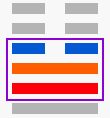Let us delve deeper and examine the trigrams, which form the building blocks of a hexagram.
The Eight Trigrams of the I Ching
There is a total of eight trigrams, representing eight different combinations of three lines, either solid (yang) or broken (yin):
 Kun, the Earth Kun, the Earth |  Dui, the Lake Dui, the Lake |  Li, the Fire Li, the Fire |  Sun, the Wind/Tree Sun, the Wind/Tree |
 Qian, the Heaven Qian, the Heaven |  Zhen, the Thunder Zhen, the Thunder |  Kan, the Water Kan, the Water |  Gen, the Mountain Gen, the Mountain |
When interpreting a hexagram it is not only important to know the meaning of a single trigram, but it is also to consider its context, were it comes from and where it goes to so-to-speak.
A Trigram’s Context
Every trigram within a hexagram has a particular context: it is embedded between a preceding and a following trigram. If we think back to our previous example: to properly assess Dui, the lake in hexagram 12 – peace, one should keep in mind that it has developed out of Qian, the heaven. And that later Zhen, the thunder will arise from Dui, the lake.
A Trigram’s Content
It is important to also understand that trigrams aren’t solid things (even though “the lake” or “the tree” might make us think so) but represent dynamic approaches to reality.
Dui is not a lake but rather behaves like a lake.
But what exactly does this mean?
This was one of the major challenges I encountered in my attempt to understand the I Ching. Fortunately, I discovered King Wen’s Later Heaven, which provides a framework for connecting trigrams with various aspects such as natural phenomena, seasons, character traits, family relationships, and more. Additionally, it enables the assignment of individual elements (or phases of transformation) from the five elements (five-element-theory) to trigrams.
Moreover, the Five Elements (five-element-theory) serves as the foundation of Traditional Chinese Medicine (TCM), including its teachings on the meridian system (system of functional circuits). It is through this shared and unifying element, the Five Elements theory, that I was able to establish a connection between trigrams and meridians.
The Five Elements Theory as a Link between Trigrams and Meridian System
The integration of trigrams, the Five Element theory and the meridian system has so far proved highly beneficial in my exploration of the meaning and dynamics of trigrams and the resulting hexagrams. Unlike much of the theoretical-heavy literature on the I Ching, Traditional Chinese Medicine (TCM) is a living art with practical application of Five Element teachings and meridian system on a daily basis. Additionally, as I do live in a physical body, the meridians function within me, within my living body, and thus offering firsthand experience of both meridians and trigrams.
Due to these reasons outlined in my research on trigrams, I have extensively studied TCM and the theory of meridians. Consequently, you will find extensive quotations from TCM literature below, as these sources have aided my understanding of the energetic qualities of trigrams. It is important to note that, much like trigrams, meridians are not objects, nor do they refer to physical organs. Instead, they can be seen as functional circuits that facilitate our interaction with the world.
Thus far, I have not come across any literature that employs a similar approach – uncovering the qualities of trigrams through the lens of TCM – making it an innovative perspective. Above all, this approach fulfills my expectations for a systematized combinatorial system like the I Ching. It provides a set of rules that rationally elucidates the oracle’s answer, while still allowing enough room for interpretation and individual conclusions.
Please take your time to delve into the study of trigrams, as they hold the key to understanding the hexagrams of the I Ching.
Excursus: Summary page of all Trigrams



